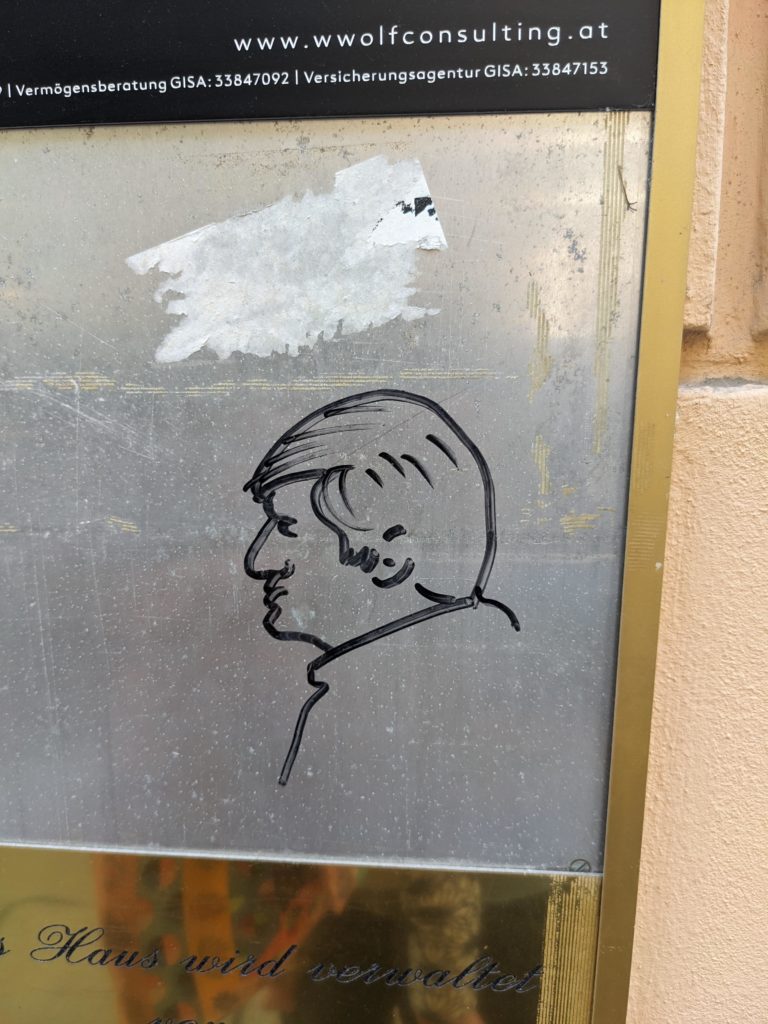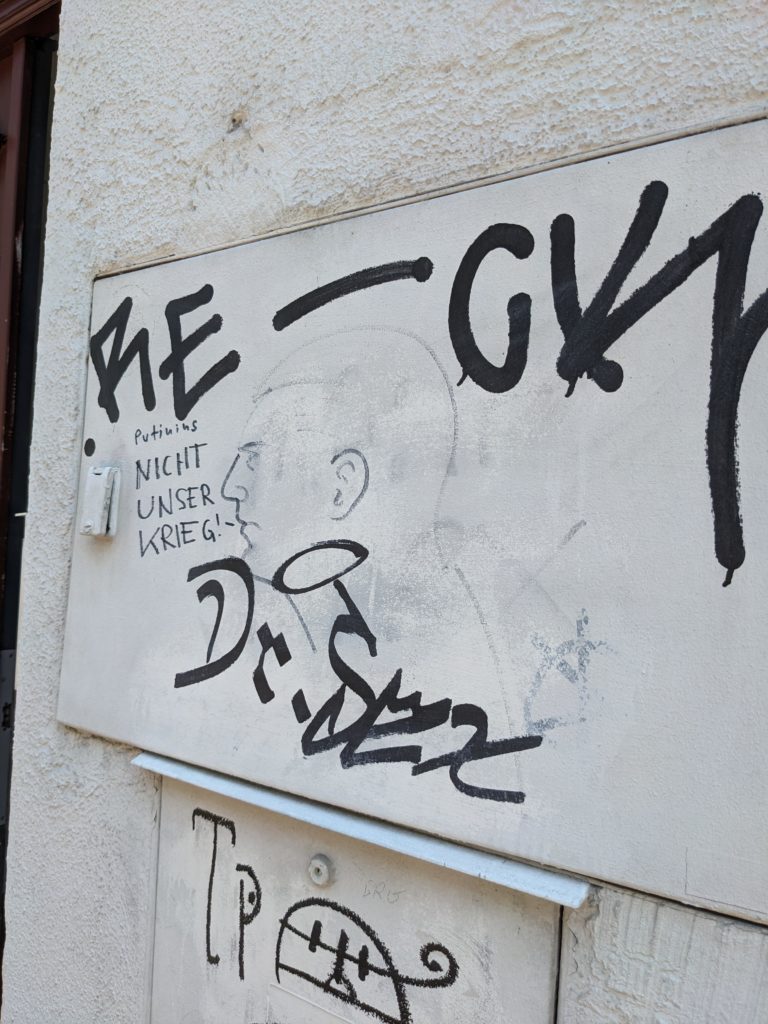I am now halfway through Bernhard’s The Loser. I find a lot about the novel confounding. It is another single paragraph inner monologue — to say a diatribe or rant would be accurate — of a would-have-been piano virtuoso who abandoned his aspirations and potential after encountering, and befriending, the Real Life piano genius of Glenn Gould. He muses on the suicide of a mutual friend, who similarly abandoned music. It is full of opinions that, judging by Wittgenstein’s Nephew, are aligned with Bernhard’s own, yet at the same time the narrator betrays himself as a reactionary blowhard in ways that suggest Bernhard is probing darker depths.
Actually, I want to take back my remark about the novel being confounding. The novel is certainly confounding in certain ways, but what really confounds me is that this is the Great Viennese Author whose books are stacked high in Shakespeare and co. It isn’t obvious to me how this happened; I’m not complaining or suspicious or irritated. Maybe I’m pleasantly surprised. But how did this happen?
When I approach the end of a book, I typically turn to Goodreads, for the spectacle of the one or two star reviews. The reviewers often write with the kind of freedom that gives the internet it’s unique flavor — is insulting celebrities on social media is really not so different from leaving The Scarlett Letter a 1-star and dismissing it as “boring and pretentious writing”? But something about the nature of Bernhard’s novel made me suspicious of anyone giving this 5-stars. Surely such a reviewer must be captive to critical consensus and received opinion.
Well, I thought I might reach out and make contact with such a reviewer, to see what they had to say. (I’m now writing long after I first wrote this diary entry. Most of these entries are heavily edited, in any case.) I went through the top 5-star reviewers, only to find them unreachable. The first reviewer who wasn’t was rather different from what I expected. First, his review was good — actually all the 5-star reviews I saw were good. It convinced me that the reviewer had 5-star feelings about the book. Second, contrary to certain assumptions about Goodreads hoi-polloi, this reviewers was a writer with bylines in esteemed publications, novels, and even a translation of Revulsions by Horacio Castellanos Moya, a Bernhard-esque rant. I don’t think we should talk about anyone being qualified. But this reviewer was, if anyone was, well qualified. That reviewer was Lee Klein, and he was kind enough to answer some questions for me:
1. Do you think the five-star Goodreads review of an esteemed classic is in danger of being as callow and gauche as the one- star review?
Stars are meaningless for classics by deceased writers. Such books are mighty oaks. Whether you hug it or take your tiny axe to it doesn’t really make a difference. On Goodreads, regardless, the all-important provision of stars relates to my reading experience more than to discernment of an innate non-existent objective of the book’s qualities. “Five stars” means really memorable, enjoyable, worthwhile, up there shining a bright light upon my sensitive readerly soul. “Five stars” means the book gave me the sort of reading experience that’s compelled me to write little reviews on that site since 2007, back when it was independent, before it was acquired by the Brazilian rainforest. Nearly 250K words I’ve spilled therein thanks mostly to the experiences I would deem “five stars.” I don’t really ever rate a book one star, and very rarely do I ever give a low rating to a living writer who’s not super-famous/wealthy. I may write about the book if it offends my delicate sophisticated sensibilities, but I don’t bother with stars.
“Callow and gauche” mean immature and unsophisticated. To quote the great poet MES: “The evil is not in extremes / It’s in the aftermath / The middle mass / After the fact / Vulturous in the aftermath.” I don’t feel like extreme reactions to art are immature and unsophisticated. The evil is in nuanced ambivalent oh-so-effin’-boring magnanimity. Three-point-five stars rounded up to four for the sake of generosity, or worse: a three-star blah back-on-the-heels reading experience rounded up to four because so many other reviewers really seem to love the book and have rated it five stars. That’s immature and unsophisticated.
Relaying one’s immediate response to art with self-critical self-consciousness, especially in extremis, is what it’s about. My mother is neither immature nor unsophisticated but she raised me to a degree to champion “five-star” greatness as a stand-in for the godhead and lump everything else as mediocre or worse (total trash). And of course this is all with an understanding that experiencing so-called greatness is personal but also, over time, expertise develops and the experienced seeker/reader/consumer may have a more refined sense of the capital-G stuff than a newer (or duller or more distracted) reader. Other than books by writers I have some connection to, books that I always rate five stars and include a “potential conflict of interest” tag, when I rate something five stars, particularly an “esteemed classic,” I mean it. Greatness is next to godliness.
2. How do you feel about The Loser with the benefit of hindsight? Over a decade of hindsight! You read it in anticipation of the Revulsion translation you did?
It’s actually been a little more than two decades since I read The Loser. I really only remember reading it on the 4 train, the Bronx Bomber, from Union Square up to Yankee Stadium in 2001 or 2002. I remember loving it and laughing to myself on the subway. I remember talking to a friend (we both edited weird little online literary journals at the time) about it, sitting in the upper deck of Yankee Stadium. I read some of it to her while we watched the game. She noted that we were probably the only people talking about Thomas Bernhard in the stadium at the time. And at the time Bernhard didn’t have the reputation he does now. He wasn’t nearly as widely read.
I learned about him via Book Forum, back when its format was more square-shaped like Art Forum than a double-long rectangle like The New York Review of Books. They had a whole special issue on Bernhard, Fall 2001. I’d never heard of him at the time. In every bookstore I went to in New York and Brooklyn, only a few of his books were available. Franzen had heard of him, of course. The Corrections, which was pretty big at the time, echoed the title of Bernhard’s Correction. Sebald’s Austerlitz also seemed influenced by Bernhard and in December 2001 Sebald admitted to being no more than another Bernhard imitator on Michael Silverblatt’s Bookworm. In Iowa City, circa 2002, I searched every one of the many bookstores in that town, and only found something like one copy of The Loser in paperback and a hardcover of Gathering Evidence I acquired.
The point is, Bernhard was known by writers but didn’t seem to have a wider reputation among readers, at least as far as I knew at the time. I read The Loser and then Woodcutters and loved them both — found them both really funny in a way. (About a decade ago I wrote a little essay about comedy in Bernhard that’s also accessible here on my site.) The mode is infectious and effective. Like reading too much DFW, it tends to affect your emails when you’re deep into reading Bernhard. You tend to introduce and repeat certain key phrases. Reading Bernhard had nothing to do with the translation New Directions ultimately published in 2016. By the time I learned about Moya’s book in Bolano’s Between Parentheses, I had already read most of Bernhard and had written in that mode too, so when I saw that the Moya book hadn’t yet been published in translation, it seemed natural for me to translate it, in part because I’d also traveled in El Salvador in the mid-’90s and had started studying Spanish in the mid-’80s and had lived in Spain for a bit.
3. You have a book out this year! Congratulations. Would you like to say something about your book? From the outside, based on all the blogs, podcasts, courses aimed at aspiring writers publishing can look like a weird logrolling/mid-level marketing scam. How does it look from your side of the fence?
Yes, thank you — Chaotic Good is my sixth published book, I think. Sagging Meniscus (a small press that specializes in unconventional stuff) published it in mid-July 2023. It’s the complement to a similar short novel Sagging Meniscus also published in 2020 called Neutral Evil ))). I’m proud of both of these books and hope they find more readers over time. They’re both autobiographical narrative essays about a particular night out to see a band (Sunn O))) in Philadelphia on March 18, 2017, in Neutral Evil ))); Phish in NYC on December 28, 2019, in Chaotic Good), with the excursion providing structure for essayistic/descriptive improvisation in any direction.
At this point I don’t really pay attention to blogs etc about publishing or writing. I was lucky enough to start writing consistently and over time self-IDing as a writer just before the advent of the internet in the ’90s. Being a writer at the time for me involved spending time in bookstores, figuring out what to read, reading as much as possible, and writing when I could. Over time I figured out how the publishing system works, either by first querying agents who then submit to larger publishers, or submitting directly to small presses if possible. Twenty or so years ago when I first started meeting lots of writers in NYC and then in Iowa when I went there for grad school, I pretty much developed a good idea about how publishing worked, or didn’t work. Youthful enthusiastic delusions/innocence have been nicely burned off since then by rejection from agents and various crushing disappointments, but also initial innocent hopes/dreams have been fulfilled often enough to make it all seem worthwhile. At this point, for me, with a full-time job and a family including a ten-year-old kid with special needs etc, writing and publishing, and reading and writing reviews on Goodreads etc, is integrated into my life. It’s part of who I am and what I do.
Generally, writing shouldn’t be about itself. It shouldn’t be about publishing. It shouldn’t be about self-marketing and associated careerist schemes. Ideally, writing is about life, and that’s pretty much it — about transforming life into lit. And if you sit and do that with enough regularity, once it’s what you do, it’s who you are. You’re a writer. Whether or not you then become an author isn’t really up to you. And once your writing is published, finding readers to bring your published work to life is a whole other kettle of coagulation. For the most part, publishing something means the piece is officially finished. Publishing to a degree kills the work. Ends it. But then readers bring it back to life, ideally, and then rate it three stars on Goodreads even when they’re your friends on there.

















